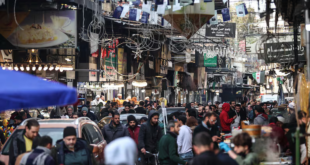Azerbaijani and ethnic Armenian forces continued to clash in and around Nagorno-Karabakh on October 23 as the top diplomats from Armenia and Azerbaijan met with U.S. Secretary of State Mike Pompeo in Washington on the decades-long conflict over the breakaway region.
Azerbaijani Foreign Minister Ceyhun Bayramov and Armenian Foreign Minister Zohrab Mnatsakanian met separately with Pompeo at the State Department. Pompeo made no substantive remarks after greeting the ministers.
Pompeo “emphasized the need to end the violence and protect civilians,” State Department spokeswoman Morgan Ortagus said in a statement after the talks.
Pompeo also stressed the importance of the sides entering substantive negotiations under the auspices of the Minsk Group of the Organization for Security and Cooperation in Europe (OSCE), Ortagus said. The United States, France, and Russia are the cochairs of the Minsk Group.
After his meeting with Pompeo, Mnatsakanyan told reporters “very good” as he exited the State Department, adding that work on a cease-fire would continue, according to Reuters.
Bayramov said he told Pompeo that the “Armenian occupation” of Nagorno-Karabakh must end.
“We are committed to finding a political solution [to] the conflict and ready to resume substantive talks immediately,” Bayramov said in a statement after the talks quoted by AFP.
“Armenia must stop avoiding meaningful negotiations and choose lasting peace,” he said.
U.S. President Donald Trump, who was asked about the talks during an impromptu press conference at the White House, said “really good progress is being made.” He noted that there are a lot of people
originally from Armenia living in the United States and “they are great people and we are going to help them.”
New Battles
Optimism that the talks might quell the fighting appeared to dim on October 22 as the two sides engaged in new battles, while leaders in Baku and Yerevan hardened their positions despite two Russian-brokered cease-fires between the Caucasus archfoes that both collapsed quickly after being agreed upon.
The two sides traded accusations about the fresh violence on October 23 that was said to include some shelling of residential areas, as attempts to broker a cease-fire shifted to Washington after the collapse of two Russian-brokered truces.
Hundreds of people have been killed since fighting flared on September 27, raising fears of a wider conflict in the South Caucasus drawing in Turkey, which backs Azerbaijan, and Russia, a key player in the region that has a military treaty with Armenia.
Shortly before the Washington talks were due to start, Turkish President Tayyip Erdogan reiterated demands for a Turkish role in mediation.
“Turkey believes it has just as much right as Russia to be involved here for peace,” he told reporters, according to Reuters. He also said he hopes Moscow and Ankara can work together on resolving the conflict.
The United States, France, and Russia have ignored calls for Turkey to play a role, with Pompeo appearing last week to send a veiled message to Ankara suggesting it was inflaming a “dangerous” situation by arming and publicly backing Baku’s actions. Turkish officials have denied the charge.
‘Cluster Munitions’
Earlier on October 23, international watchdog Human Rights Watch (HRW) accused Azerbaijan of “repeatedly” using widely banned cluster munitions in residential areas in Nagorno-Karabakh.
HRW cited four such incidents based on “an on-site investigation” in the breakaway Azerbaijani territory, which is mostly populated by ethnic Armenians and has been at the heart of post-Soviet Europe’s longest running “frozen conflict.”
Cluster munitions are banned due to their unpredictable effects across a widespread area, as well as long-term dangers from unexploded submunitions. They can be dropped from the air or fired from the ground.
Both the Azerbaijani and Armenian sides have denied using cluster bombs while accusing the other of firing them.
HRW said it had not verified Azerbaijan’s claims that the Armenian side had used cluster munitions.
HRW said its observers personally inspected “remnants of the rockets, impacts, and remnants of submunitions that exploded, as well as dud submunitions” fired by Azerbaijani forces at several locations in Stepanakert.
Until recently, Stepanakert housed around 55,000 of the mountainous region’s 150,000 or so people, but the city has been devastated by artillery and other fire in the current fighting.
Azerbaijan denounced the Amnesty statement, insisting that the Azerbaijani army is not deliberately targeting civilians in Nagorno-Karabakh.
 Eurasia Press & News
Eurasia Press & News



